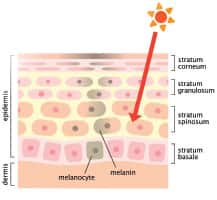Life Extension Magazine®
Age spots and dark patches create dull, uneven skin tone that robs youthful appearance.
These undesirable changes result from increased amounts of the skin’s main pigment, melanin, as we age.1-3
Scientists have found that two topically-applied compounds, glutathione and niacinamide, inhibit multiple stages of melanin synthesis to produce a skin-brightening effect.
Additional topical compounds promote the appearance of brighter skin by boosting collagen synthesis and enhancing DNA repair.
Targeting Multiple Stages of Melanin Production

When sunlight hits the skin, specialized cells called melanocytes produce small amounts of the pigment melanin to help protect against the damaging effects of ultraviolet rays.4,5
Chronic sun exposure, however, along with other factors such as heredity and hormonal changes, trigger melanocytes to excessively produce melanin.6-8
This manifests as age spots and difficult-to-treat melasma (dark, discolored patches on skin).
As the years pass, the process of melanin synthesis becomes dysregulated and contributes to older-looking skin.
Two compounds have been shown to impede melanin production to favorably modulate skin pigmentation.
Glutathione Inhibits Tyrosinase Activation

Glutathione is a naturally occurring tripeptide found inside every cell, where it plays a crucial role in antioxidant defense, immunity, and detoxification.12,13
In addition, glutathione has been shown to exhibit anti-melanogenic properties.14
It binds to the copper-containing site of tyrosinase, in turn preventing its activation, and thus the signal to turn on melanin output.14,15 Thanks to its potent antioxidant effects, glutathione combats UV-induced free radicals that induce tyrosinase activity.5,16
Human studies show that topical glutathione results in a clearer and more even complexion. In a randomized, double-blind, controlled study, female subjects topically applied glutathione twice daily to one side of the face and a placebo to the other for 10 weeks.17
Compared to the placebo group, the glutathione-treated group showed a significant decrease in melanin index—an indicator of the skin’s melanin content—as well as diminished wrinkles and improved skin moisture and smoothness.17
Other research has established the effectiveness of topical glutathione to treat a common pigmentation disorder known as melasma that affects mostly women in the facial area.18,19
In one clinical study, topical glutathione significantly reduced the melasma area and severity index compared to a placebo, which translated into brighter skin for participants at the study’s end.19 This is noteworthy, since melasma has been historically difficult to treat.20
Niacinamide and Skin Pigmentation

Niacinamide is a form of niacin (vitamin B3) shown to combat skin aging by boosting antioxidant capacity, improving epidermal barrier function, and modulating pigmentation.21
Randomized, double-blind, placebo-controlled human trials demonstrate that topical niacinamide significantly decreases facial skin yellowing, blotchiness, wrinkling, and excess pigmentation after three months.22,23
In a double-blind clinical trial, females aged 25-60 with multiple types of brown patches, topically applied niacinamide twice daily to one side of the face and a placebo to the other for eight weeks.24
Compared to baseline, the treatment group decreased total area of hyperpigmentation by 25% versus only 15% in the placebo group. Topical niacinamide was well-tolerated by participants.24
Researchers found that topical niacinamide was comparable to the gold-standard hydroquinone for treating melasma, but importantly accomplished this with fewer side effects.25
Clinical improvements in the niacinamide-treated group were correlated with skin biopsy evidence of significant reductions in epidermal melanin and inflammation.25
What you need to know
Eliminate Age-Related Skin Discoloration

- Melanin is the predominant pigment in the skin that protects against damaging ultraviolet rays.
- Chronic sun exposure, along with other factors like heredity and hormonal changes, cause melanocytes to overproduce melanin.
- This manifests in the outward appearance of dull skin, uneven skin tone, age spots, dark patches, and melasma.
- Researchers have found two compounds that work together to inhibit multiple stages of melanin synthesis.
- Glutathione is a tripeptide that slows down tyrosinase activity by binding to its copper-containing active site and combating UV-induced oxidative stress.
- Niacinamide is a form of vitamin B3 that blocks the transfer of melanin-filled melanosomes from melanocytes to keratinocytes on the skin’s surface.
- Additional agents—palmitoyl tripeptide-5, acetyl hexapeptide-51 amide, Aspalathus linearis leaf extract—promote the appearance of brighter skin by boosting collagen synthesis, enhancing DNA repair, and exerting potent antioxidant effects.
Additional Compounds Support Brighter Skin

While glutathione and niacinamide work to normalize melanin output, several other compounds have been shown to support the appearance of more luminous skin by protecting and rebuilding the skin’s underlying architecture. They are:
1. Palmitoyl Tripeptide-5
The loss of collagen as we age results in dry, dull-looking skin accompanied by wrinkles and increased pigmentation.
Scientists have discovered that palmitoyl tri-peptide-5 stimulates collagen synthesis.26
Together with other peptides, palmitoyl tripeptide-5 has been shown in clinical trials to reduce fine lines and wrinkles, as well as improve skin texture, tone, and radiance.26,27 In other words, palmitoyl tripeptide-5 makes aging skin appear more plump, youthful, and radiant.
2. Acetyl Hexapeptide-51 Amide
Environmental factors and internal aging inflict DNA damage that, if left unrepaired, can add years to your perceived age. Acetyl hexapeptide-51 amide has been found to protect against DNA damage and switch on beneficial genes involved in DNA repair.28
In the laboratory, acetyl hexapeptide-51 amide produced a 2.7-fold increase in DNA repair pathways when exposed to human skin cells, compared to a control.28
This explains the finding of a later study in which humans topically applying acetyl hexapeptide-51 amide after exposure to ultraviolet light had 13.7% less DNA damage than controls.28 By preserving DNA integrity, acetyl hexapeptide-51 amide ensures the continuous production of new skin cells that have a fresh, more radiant appearance.
3. Aspalathus linearis Leaf Extract
Overexposure to ultraviolet radiation generates a storm of free radicals and oxidative stress that paves the way for wrinkles, fine lines, mottled pigmentation, and skin cancer.
Aspalathus linearis is a South African plant well-known for its potent antioxidant and anti-inflammatory properties that scavenge free radicals, and provides significant protection against sun-induced skin damage.29,30
Summary

The excessive output of the skin’s melanin produces an uneven pigmentation that can make your skin appear older.
Topical glutathione and niacinamide have been shown to normalize melanin output to fade age spots, dark patches, and melasma.
Several other agents—palmitoyl tripeptide-5, acetyl hexapeptide-51 amide, Aspalathus linearis leaf extract—have been shown to aid in the appearance of brighter skin.
If you have any questions on the scientific content of this article, please call a Life Extension® Wellness Specialist at 1-866-864-3027.
Gary Goldfaden, MD, is a clinical dermatologist and lifetime member of the American Academy of Dermatology. He is the founder of Academy Dermatology in Hollywood, FL, and Cosmesis Skin Care. Dr. Goldfaden is a member of the Life Extension® Medical Advisory Board. All Cosmesis products are available online.
References
- Skoczynska A, Budzisz E, Trznadel-Grodzka E, et al. Melanin and lipofuscin as hallmarks of skin aging. Postepy Dermatol Alergol. 2017 Apr;34(2):97-103.
- Ortonne JP. Pigmentary changes of the ageing skin. Br J Dermatol. 1990 Apr;122 Suppl 35:21-8.
- Porta EA. Pigments in aging: an overview. Ann N Y Acad Sci. 2002 Apr;959:57-65.
- Brenner M, Hearing VJ. The protective role of melanin against UV damage in human skin. Photochem Photobiol. 2008 May-Jun;84(3):539-49.
- D’Orazio J, Jarrett S, Amaro-Ortiz A, et al. UV radiation and the skin. Int J Mol Sci. 2013 Jun 7;14(6):12222-48.
- Costin GE, Hearing VJ. Human skin pigmentation: melanocytes modulate skin color in response to stress. FASEB J. 2007 Apr;21(4):976-94.
- Ortonne JP. The effects of ultraviolet exposure on skin melanin pigmentation. J Int Med Res. 1990;18 Suppl 3:8C-17C.
- Baxter LL, Pavan WJ. The etiology and molecular genetics of human pigmentation disorders. Wiley Interdiscip Rev Dev Biol. 2013 May-Jun;2(3):379-92.
- Videira IF, Moura DF, Magina S. Mechanisms regulating melanogenesis. An Bras Dermatol. 2013 Jan-Feb;88(1):76-83.
- Rzepka Z, Buszman E, Beberok A, et al. From tyrosine to melanin: Signaling pathways and factors regulating melanogenesis. Postepy Hig Med Dosw (Online). 2016 Jun 30;70(0):695-708.
- Park HY, Kosmadaki M, Yaar M, et al. Cellular mechanisms regulating human melanogenesis. Cell Mol Life Sci. 2009 May;66(9):1493-506.
- Forman HJ, Zhang H, Rinna A. Glutathione: overview of its protective roles, measurement, and biosynthesis. Mol Aspects Med. 2009 Feb-Apr;30(1-2):1-12.
- Droge W, Breitkreutz R. Glutathione and immune function. Proc Nutr Soc. 2000 Nov;59(4):595-600.
- Villarama CD, Maibach HI. Glutathione as a depigmenting agent: an overview. Int J Cosmet Sci. 2005 Jun;27(3):147-53.
- Jara JR, Aroca P, Solano F, et al. The role of sulfhydryl compounds in mammalian melanogenesis: the effect of cysteine and glutathione upon tyrosinase and the intermediates of the pathway. Biochim Biophys Acta. 1988 Nov 17;967(2):296-303.
- Denat L, Kadekaro AL, Marrot L, et al. Melanocytes as instigators and victims of oxidative stress. J Invest Dermatol. 2014 Jun;134(6):1512-8.
- Watanabe F, Hashizume E, Chan GP, et al. Skin-whitening and skin-condition-improving effects of topical oxidized glutathione: a double-blind and placebo-controlled clinical trial in healthy women. Clin Cosmet Investig Dermatol. 2014;7:267-74.
- Ogbechie-Godec OA, Elbuluk N. Melasma: an Up-to-Date Comprehensive Review. Dermatol Ther (Heidelb). 2017 Sep;7(3):305-18.
- Lamia H. El-Garhy MDALSAFMS, Basma M. Ali MDNAE-MMD. Evaluation of the Efficacy and Safety of Topical and Oral Glutathione in Treatment of Melasma. The Medical Journal of Cairo University. 2018 09/01;86(9):3083-92.
- Sarkar R, Ailawadi P. Treatment of Melasma: The Journey Ahead. Indian J Dermatol. 2017 Nov-Dec;62(6):555-7.
- Levin J, Momin SB. How much do we really know about our favorite cosmeceutical ingredients? J Clin Aesthet Dermatol. 2010 Feb;3(2):22-41.
- Bissett DL, Oblong JE, Berge CA. Niacinamide: A B vitamin that improves aging facial skin appearance. Dermatol Surg. 2005 Jul;31(7 Pt 2):860-5; discussion 5.
- Bissett DL, Miyamoto K, Sun P, et al. Topical niacinamide reduces yellowing, wrinkling, red blotchiness, and hyperpigmented spots in aging facial skin. Int J Cosmet Sci. 2004 Oct;26(5):231-8.
- Hakozaki T, Minwalla L, Zhuang J, et al. The effect of niacinamide on reducing cutaneous pigmentation and suppression of melanosome transfer. Br J Dermatol. 2002 Jul;147(1):20-31.
- Navarrete-Solis J, Castanedo-Cazares JP, Torres-Alvarez B, et al. A Double-Blind, Randomized Clinical Trial of Niacinamide 4% versus Hydroquinone 4% in the Treatment of Melasma. Dermatol Res Pract. 2011;2011:379173.
- Trookman NS, Rizer RL, Ford R, et al. Immediate and Long-term Clinical Benefits of a Topical Treatment for Facial Lines and Wrinkles. J Clin Aesthet Dermatol. 2009 Mar;2(3):38-43.
- Sonti S, Makino ET, Garruto JA, et al. Efficacy of a novel treatment serum in the improvement of photodamaged skin. Int J Cosmet Sci. 2013 Apr;35(2):156-62.
- Available at: http://www.aromatheka.com/descargas/JUVELEVEN.pdf. Accessed March 15, 2021.
- Magcwebeba T, Swart P, Swanevelder S, et al. Anti-Inflammatory Effects of Aspalathus linearis and Cyclopia spp. Extracts in a UVB/Keratinocyte (HaCaT) Model Utilising Interleukin-1alpha Accumulation as Biomarker. Molecules. 2016 Oct 2;21(10).
- McKay DL, Blumberg JB. A review of the bioactivity of South African herbal teas: rooibos (Aspalathus linearis) and honeybush (Cyclopia intermedia). Phytother Res. 2007 Jan;21(1):1-16.

